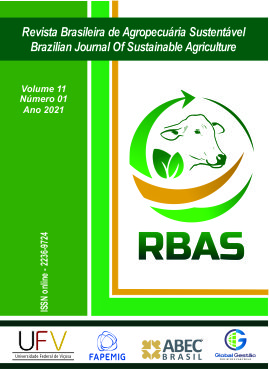RESPOSTA DO FEIJOEIRO E DO TRIGO A LÂMINAS DE IRRIGAÇÃO EM DIFERENTES CONDIÇÕES DE SOLO
DOI:
https://doi.org/10.21206/rbas.v11i1.10721Keywords:
Compactação do solo;, Deficiência hídrica;, Evapotranspiração;, Phaseolus vulgaris;, Triticum aestivumAbstract
The layers of water applied and the physical characteristics of the soil are properties that, isolated or not, can influence the physiological and productive development of most agricultural crops. Therefore, the objective of this work was to evaluate the response of the bean crop, cultivar BRS FC 104 and wheat, cultivar BRS 404, submitted to different irrigation depths and soil conditions. The cultivation of beans and wheat was carried out at the University of Rio Verde, in pots, under field conditions with five levels of irrigation depths (50%, 75%, 100%, 125% and 150% of the crop evapotranspiration - ETc) and three soil conditions (compacted, non-compacted and not compacted with straw), with three replications. The evaluations were carried out fortnightly. In common bean culture it was evaluated: emergence, stem diameter, plant height, leaf length and width, number of pods and number and mass of grains. While, in the wheat crop were avaluated: emergence, number of tillers, plant height, weight of green and dry root and green mass. In general, both evaluated cultures showed better performance when cultivated in unpacked soil with straw. The increase in irrigation depths above 100% did not promote additional gains for crops. Irrigation depths below 100% (75% and 50% of ETc) hindered the development of beans and wheat.
Downloads
Downloads
Published
How to Cite
Issue
Section
License
Copyright (c) 2021 Brazilian Journal of Sustainable Agriculture

This work is licensed under a Creative Commons Attribution-NonCommercial-NoDerivatives 4.0 International License.
1. Proposta de Política para Periódicos de Acesso Livre
Autores que publicam nesta revista concordam com os seguintes termos:
Autores mantém os direitos autorais e concedem à revista o direito de primeira publicação, com o trabalho simultaneamente licenciado sob a Licença Creative Commons Attribution que permite o compartilhamento do trabalho com reconhecimento da autoria e publicação inicial nesta revista.











